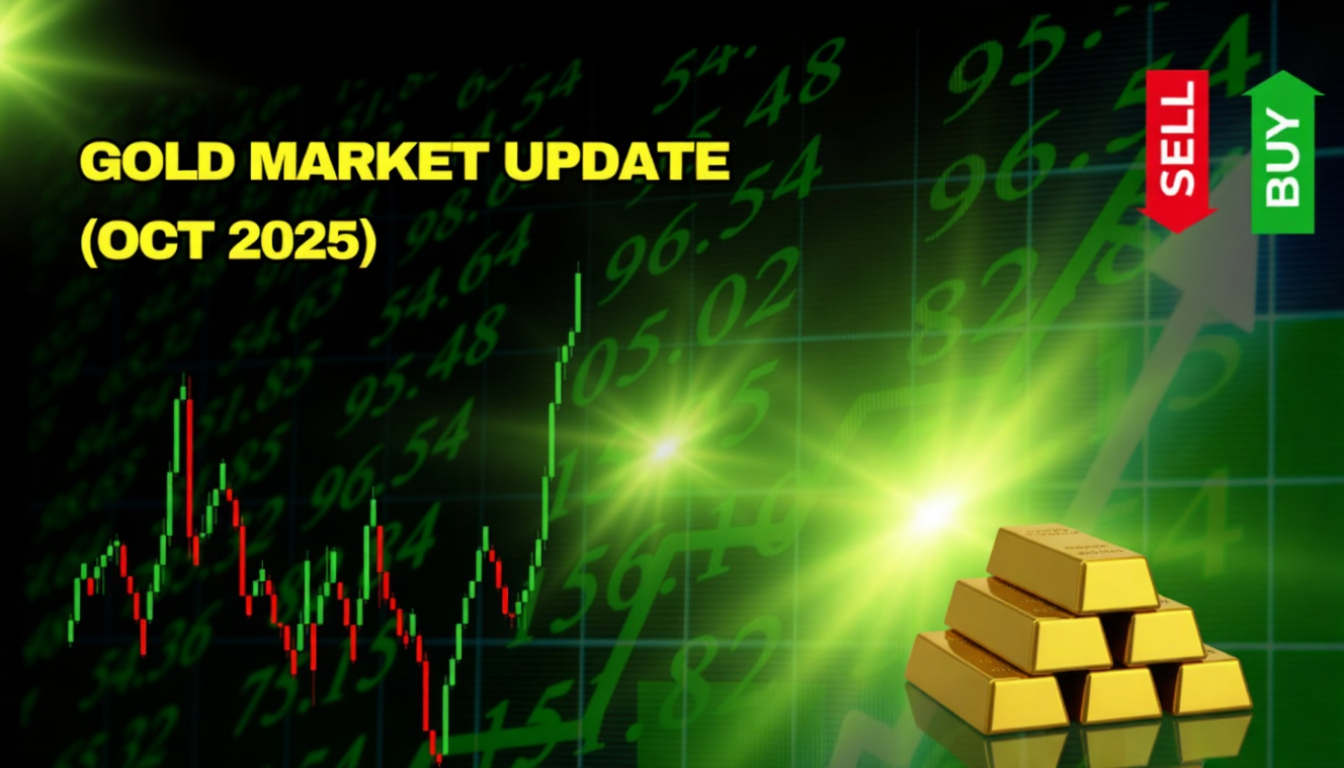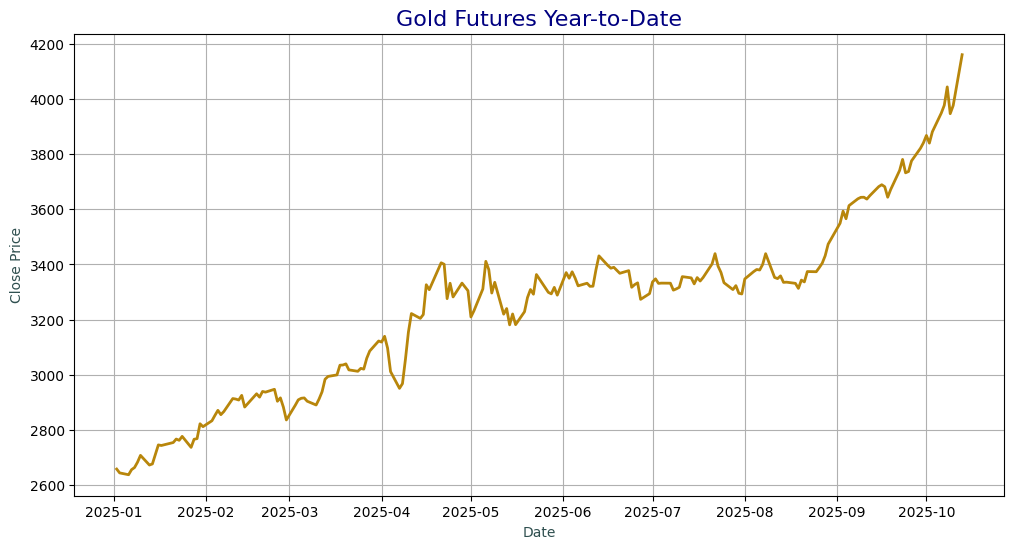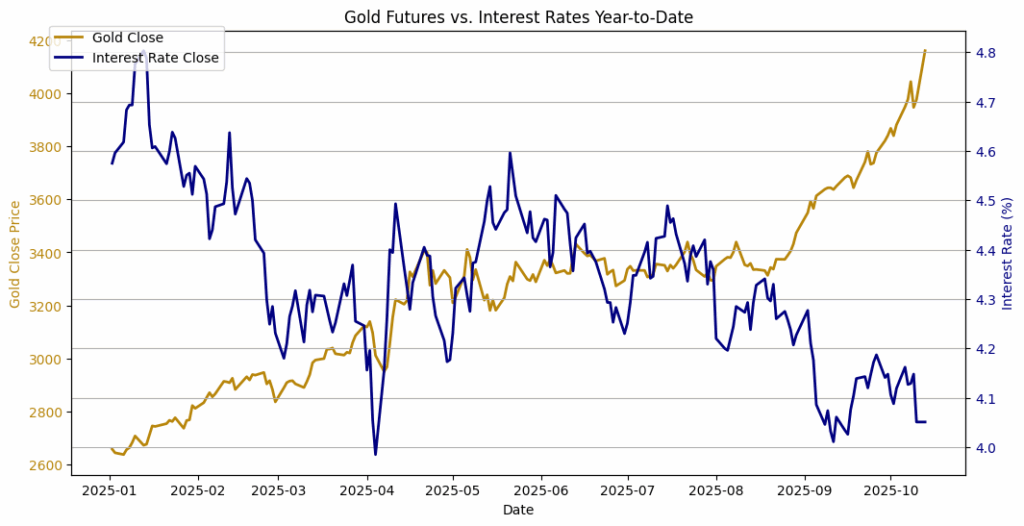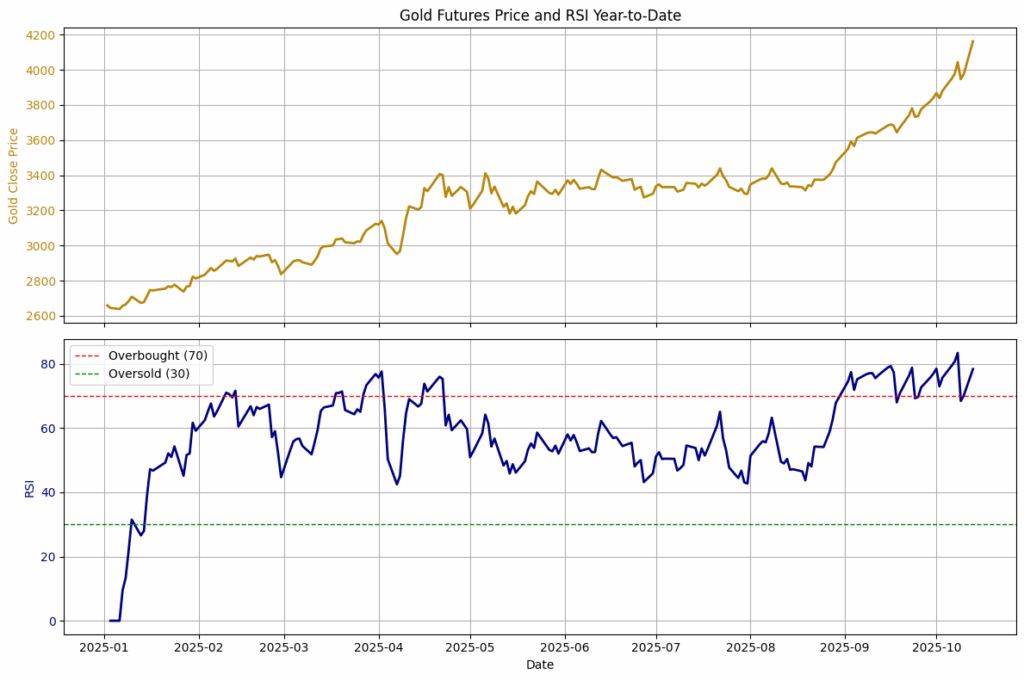
October 13, 2025
Gold Market Update (Oct 2025): Are New All-Time Highs Justified?
Gold has been on a tear in 2025, recently surging to record levels. In early October, gold prices rocketed past the $4,000 per ounce mark, an astonishing feat for an asset that was around $2,150 just five months ago[1][2]. Year-to-date, gold has gained over 50%, vastly outperforming stocks, bonds, and oil[3]. This rally has captured the attention of retail traders and seasoned investors alike. The big question on everyone’s mind: Is gold’s new all-time high justified by fundamentals, or is it an overbought rally due for a pullback? Let’s break down what’s happening with gold as of October 12, 2025 – and see how our May 2025 analysis held up in hindsight.
Gold at Record Highs: A Quick Recap of 2025’s Rally
Gold’s ascent this year has been nothing short of remarkable. Back in May 2025, gold was already strong – trading around $2,150/oz with nearly 20% gains since January[1]. At that time, our analysis noted that gold was hitting “significant highs” amid persistent inflation, geopolitical tensions, and heavy central bank buying[4]. Fast forward to October, and gold blew past its previous peak (~$2,300 in early May) to reach a fresh all-time high around $4,059 on October 8[5]. This new peak came amidst heightened market anxiety – the U.S. government was over a week into a shutdown, and investors were pouring into gold exchange-traded funds (ETFs) as a safe haven[5]. By mid-October, gold has hovered near $4,000, holding most of its explosive gains even after some profit-taking.

This rally means that gold is one of 2025’s best-performing major assets, delivering solid double-digit (indeed, now double-digit times two) returns. It has outpaced equities and even other commodities, underscoring its renewed “safe-haven” status in a turbulent year[3]. Both institutional and retail investors have flocked to gold, a notable shift since retail interest was muted during prior peaks. In fact, long-term money has been flowing steadily into gold, with buyers showing little sign of retreat despite the lofty prices[6]. Clearly, 2025 has been gold’s time to shine.
What’s Driving Gold’s Record Run?
Several key factors have converged to drive gold to these record heights. Here are the main drivers behind gold’s 2025 surge:
- Sticky Inflation and Hopes of Lower Interest Rates: Inflation has remained stubbornly above central bank targets this year, keeping investors worried about the erosion of purchasing power[7]. In the U.S., inflation is still “sticky” in the mid-single digits, and while it’s off peak levels, it hasn’t calmed to the Fed’s 2% comfort zone. This backdrop makes gold attractive as an inflation hedge. Meanwhile, after aggressive rate hikes in 2022–2024, central banks have shifted stance in 2025. The Federal Reserve held rates high through mid-year but then signaled a pivot – even cutting rates in September 2025 as growth fears rose. The mere expectation of Fed rate cuts has been rocket fuel for gold, since lower interest rates reduce the opportunity cost of holding a non-yielding asset like gold[8]. In short, investors see a future of lower real yields and want gold as protection.

- Central Bank Buying Spree: Central banks around the world (especially in Asia and the Middle East) have been massive buyers of gold in recent years – and 2025 is no exception. In 2023, official sector purchases hit a record ~1,040 tonnes, and 2024 saw around 950 tonnes added[9]. That trend has continued strongly into 2025, with central banks on pace to accumulate roughly another 900 tonnes this year[10]. Countries like China, Russia, Turkey, and India have been consistently boosting their gold reserves. In fact, China’s central bank has added gold for 11 consecutive months through September[11]. The motivation? Reserve diversification and security. By holding more gold (an asset with no counterparty risk), these nations seek stability and independence from the U.S. dollar. This steady official demand provides a firm floor under the gold market – even if private investment ebbs at times. In 2025, it also added upside momentum: central bank buying has been a major driver of gold’s strength[12], signaling to the market that big players see value in gold at these prices.
- Geopolitical and Safe-Haven Demand: Unfortunately for the world, 2025 has been rife with geopolitical and political tensions – which is actually bullish for gold. Ongoing conflicts and uncertainties have kept investors on edge. The war in Eastern Europe (e.g. continued conflict in Ukraine) shows no sign of fully abating, with periodic escalations like renewed drone and missile attacks[13]. The Middle East remains fragile as well, flirting with instability[14]. On top of that, 2025 brought political turmoil in the West: in the U.S., a fierce budget standoff led to a government shutdown that dragged on, undermining confidence. Meanwhile, trade tensions have resurfaced – the U.S.–China trade conflict kicked back into gear when President Trump threatened new tariffs, rattling markets[15]. All these events have created a pervasive sense of uncertainty. Investors large and small have responded by moving into safe havens, chief among them gold. Safe-haven demand has been a huge factor in gold’s rally, as people seek an asset that can hold value when headlines turn alarming[2][7]. Essentially, gold has been insurance against a very uncertain world this year.
- Weaker Dollar Boost: Gold often moves inversely to the U.S. dollar, and 2025 has exemplified this pattern. With the Fed’s stance softening and U.S. political risks rising, the U.S. dollar index (DXY) has slid lower. By April 2025, the dollar was already down ~4.5% for the year[16], and further weakening followed as rate-cut talk intensified and global investors lost a bit of confidence in U.S. fiscal stability. A weaker dollar makes gold (priced in USD globally) cheaper for foreign buyers and generally lifts gold’s USD price. In essence, part of gold’s price jump can be seen as the mirror image of a dollar decline[7]. The dollar’s stumble has provided that extra tailwind for bullion prices this year.
- Investor Demand & Momentum: Beyond central banks, private investors have also piled into gold. Earlier in the rally, a lot of the buying came from institutions rotating into gold for diversification. Notably, gold-backed ETFs saw a return to net inflows in 2025 after outflows in the prior two years – by May, about 150 tonnes had already flowed into gold ETFs year-to-date[17]. This trend continued as prices climbed. Lately, we’re even seeing retail investors jumping on the bandwagon, which wasn’t as evident during gold’s previous peaks. (One analysis pointed out that the retail crowd was absent at earlier highs like in 2011, but this time they’ve joined in, adding more fuel to the fire[18].) Once gold broke its past records, some “fear of missing out” (FOMO) likely kicked in – rising prices attracted even more buyers, which in turn pushed prices higher. This positive feedback loop has helped gold sustain its upward momentum deeper into the year than many expected.
In short, the fundamental backdrop for gold in 2025 has been extremely supportive. High inflation, shifting central bank policies, voracious official sector buying, global turmoil, a softer dollar, and enthusiastic investors have all combined to drive gold to new heights. It’s a perfect recipe that explains why gold is where it is today.
Technical Trends: From $2,300 to $4,000 (Breaking Barriers)
From a technical market standpoint, gold’s move has been powerful. Earlier in the year, analysts identified $2,300 per ounce as a major resistance – that was the previous record high set in May 2025[19]. Indeed, gold did struggle around the low $2,200s for a while in the spring. But once that ceiling broke, it turned into a floor, and the metal never looked back. The rally accelerated over the summer and especially in the autumn as gold blew past $3,000, then $3,500, and ultimately $4,000. Each round-number milestone became more of a psychological marker than a true barrier – momentum and fundamentals carried gold upward with surprising ease.
Now, with prices around $4k, technical analysts are mapping out new support and resistance levels in uncharted territory. Recent trading suggests that the $3,900–$4,000 zone has become an important support region (buyers have consistently stepped in on dips near there). In fact, after gold hit its peak ~$4,059, it saw only a mild pullback – sellers couldn’t push it below about $3,944 before demand kicked in[20]. On the upside, traders are eyeing potential resistance at roughly $4,100+ (recent high marks in the $4,060-$4,130 area)[21]. For now, the trend is clearly bullish: gold continues to trade above its key moving averages, and the series of higher highs and higher lows remains intact.
That said, there are signs that the market is running hot in the short term. By many measures, gold is overbought after such a steep climb. Momentum indicators like the RSI have been hovering at high levels, and we’ve seen a quick jump in bullish sentiment. It’s no surprise that some analysts are warning the rally “can’t continue in a straight line” without a pause[22]. A short-term correction of maybe 10% (which would be a dip of a few hundred dollars from these levels) “would be healthy” after the rapid run-up, according to market experts[22]. In plainer terms: a pullback to, say, the mid-$3,500s would not break gold’s uptrend – it might even strengthen the longer-term bull case by shaking out weak hands and alleviating the overbought conditions.

Despite the potential for near-term wobbles, the bigger technical picture still looks strong. Volatility in gold has increased alongside its gains (not unexpected – big moves bring bigger swings), but as long as gold stays above major support levels, the bulls remain in control. The May 2025 analysis noted that gold was safely above its 50-day and 200-day moving averages back then[23]; that remains true now, just on a much larger price scale. In fact, gold would have to drop quite a lot to even touch its 50-day average at this point. The old all-time high of $2,300 is so far below current prices that it’s almost irrelevant as a technical reference now – a remarkable statement in itself! The next battle for chart-watchers is to see if gold can consolidate above $4,000 and build a new base, or if it needs a deeper breather before attempting to make further highs. Overall, the technical trend is bullish but stretched, so caution and good risk management are key for traders entering at these elevated levels.
Revisiting the May 2025 Analysis: What Was Right and What Changed
Back in May, we published a “Gold Market Pulse” analysis, so it’s worth checking in on those expectations versus what actually happened. In that May 2025 report, we highlighted many of the same bullish drivers that are in play now – and time has proven a lot of those points to be prescient:
- Inflation and Fed Policy: The May analysis noted that inflation was running at 3%+ and that the Federal Reserve had kept interest rates high longer than expected, which created headwinds for gold – but it also suggested a pivot to rate cuts could be coming later in 2025[24][25]. Indeed, that’s exactly what unfolded. Inflation remained above target (today it’s still elevated, validating gold’s role as an inflation hedge), and the Fed did shift course by late 2025 toward easing. That anticipated policy pivot was a key driver of gold’s strength, just as predicted[25]. If anything, the Fed turned dovish a bit sooner or more aggressively than many thought, which turbocharged gold’s rally beyond the modest upside envisioned in spring.
- Central Bank Buying: Our May outlook emphasized the surge in central bank gold purchases – particularly by emerging economies diversifying away from the dollar – as a “substantial support” for prices[26]. This has absolutely continued. Central banks remained voracious buyers through the year, and this consistent demand indeed put a firm floor under the market. In May we expected around 900 tonnes of official sector buying in 2025[10]; that seems on track, if not higher, given the pace of purchases by countries like China (which alone added gold for 11 straight months)[11]. The May analysis got it right that central bank behavior would be pivotal in keeping the gold bull trend intact.
- Geopolitical Tensions: Our previous report pointed to ongoing geopolitical conflicts and uncertainties as factors that had increased gold’s safe-haven appeal[27][28]. This too was spot on. Sadly, the world didn’t get calmer since May – if anything, new political flare-ups (like the U.S.–China trade spat reigniting, or domestic political dramas) joined the persistent conflicts abroad. The “geopolitical premium” on gold stayed elevated, exactly as anticipated[28]. Gold benefited from this persistent demand by investors looking for a hedge against worst-case scenarios.
- Bullish Trajectory – But Magnitude Underestimated: In May, we maintained a bullish stance on gold, suggesting it would likely “maintain its bullish trajectory through the remainder of 2025”[29]. We even cited consensus forecasts that saw gold potentially reaching the $2,350–$2,450 range toward the end of the year[29]. In hindsight, that target looks conservative – gold blasted through $2,450 just a couple months after that report and nearly doubled by October! So while the direction of the call was correct (gold did continue to rally), the scale of the move was far greater than expected. What changed? Simply put, many of the supportive factors became even more pronounced in the second half of 2025. Inflation didn’t fade as quickly as some hoped. The Fed’s tilt to easing came with a still-tight job market – a recipe some would call “stagflation-light,” which is very gold-friendly. Geopolitical events piled on. And once gold started making headlines by smashing records, the momentum took on a life of its own. Our May analysis didn’t fully foresee the U.S. political turmoil (e.g. the protracted government shutdown) or the renewed trade war rhetoric that emerged later in the year – developments that gave gold an extra jolt. In summary, the May outlook correctly identified the bullish drivers, but actual outcomes overshot on the upside. It’s a reminder that markets can surprise, even when you’re leaning the right way.
- Technical Levels and Trends: We also discussed key technical levels in May – notably $2,300 as a big resistance and $2,000 as major support[19]. We suggested the market structure was bullish above the 50-day moving average[23]. Those observations held true, but gold moved so far beyond the old range that new technical levels had to be developed. The breach of $2,300 was the catalyst we thought it might be (and then some!). After that, technical analysis had to adjust to new milestones like $3,000 and $4,000, which weren’t on the radar back in spring. One thing we noted was that gold often has a strong late-summer into fall seasonal tendency (Indian wedding season, etc.), but 2025’s gains “exceeded typical seasonal expectations” due to structural factors[30]. That turned out to be an understatement – the usual autumn gold strength was turbocharged by those structural drivers. In essence, the May report got the story right but the ending even more dramatic than imagined.
It’s interesting to look back: the core narrative from May 2025 aged well – inflation, central banks, and geopolitics did keep gold on an upward path – but the extent of gold’s rise shows how unpredictable and fast-moving markets can be. If you were bullish in May, you’ve been rewarded even more than you hoped. And if you were skeptical then, the subsequent rally has likely been shocking.
Is Gold’s All-Time High Justified, or Are We in Bubble Territory?
With gold now near $4,000/oz, a level never seen before this month, it’s natural to ask whether this pricing is fundamentally justified or simply a speculative overshoot. The evidence suggests that the high price of gold is largely supported by real factors, though the rapid pace of the climb might be difficult to sustain in the very short term.
On one hand, there are solid reasons behind gold’s strength. We have a macroeconomic environment of persistent (if moderating) inflation and shifting monetary policy. Even after recent Fed rate cuts, real interest rates (rates minus inflation) remain low – and could even turn negative if inflation proves sticky while nominal rates fall. Historically, gold thrives in low-real-yield climates. Moreover, central banks and large investors are treating gold as a valuable reserve asset in uncertain times, and they’re buying accordingly. This isn’t just speculators piling in; it’s sovereign entities and institutional investors making strategic allocations to gold for the long haul[12]. Such structural demand lends credibility to gold’s price levels. Gold is increasingly seen as regaining its role as the ultimate store of value in a volatile global economy[31]. When you consider the backdrop – unsteady geopolitics, questions about fiat currency stability, and the longest stretch of central bank gold buying in decades – it makes sense that gold would be re-priced to a higher plateau. In fact, some analysts argue that gold’s prior highs (around $2,000) didn’t fully account for the post-COVID surge in global debt and geopolitical risk. From that perspective, $4,000 gold reflects a new equilibrium where gold better balances the risks in the world.
It’s also telling that major financial institutions remain bullish even at these prices. For instance, economists at ING project gold will average about $4,150 in 2026 (implying they expect prices to stick around current levels or higher), and Goldman Sachs recently raised its gold target to $4,900 by the end of 2026[32][33]. Such forecasts suggest that big players see the current highs not as a fluke, but as part of an ongoing trend supported by inflation concerns, central bank accumulation, and investor diversification. As long as those pillars remain in place – and so far, we’ve seen nothing to suggest a reversal in, say, central bank behavior or a sudden outbreak of global peace and fiscal prudence – there is a case to be made that gold’s high price is fundamentally justified.
On the other hand, we must acknowledge that markets can and do overshoot in the short term. Gold’s near-vertical climb in recent months has likely been faster than fundamentals alone would dictate. There’s a momentum and sentiment component here too – gold became the “hot trade” and probably moved a bit beyond equilibrium in the excitement. Technical indicators, as mentioned, point to an overbought market[22]. When everyone who wants to buy has already bought, even a great asset can see a pullback. We’re already hearing cautious voices: many experts are warning that a pullback or correction is due after the record run[22]. This doesn’t mean gold is doomed to crash, but it suggests we could see some choppy trading or a dip if some of those crowded long positions unwind or if there’s a piece of good news (for the world) that diminishes safe-haven demand temporarily. Short-term corrections can be healthy, allowing the market to digest gains and preventing a larger bubble from forming.
Gold’s recent all-time high appears to be grounded in strong fundamentals – not a baseless frenzy. Inflationary pressures, a weaker dollar, central bank buying, and global risks all provide a rationale for why gold should be valued higher now than, say, a couple of years ago. That said, the speed of the ascent might be due for a reality check. A bit of cooling-off would actually reinforce the idea that this is a measured bull market rather than an irrational spike. So, is the ATH justified? Yes, insofar as the drivers supporting it are real and look likely to persist. But don’t be surprised if gold takes a breather; even the strongest bull markets need to consolidate occasionally.
Bottom Line for Retail Investors
For everyday investors, the gold market’s journey in 2025 offers a few takeaways. First, gold has once again proven why it’s considered a safe-haven asset. In a year full of unpredictable events – from economic policy shifts to geopolitical flare-ups – gold provided protection and impressive returns. Having some exposure to gold (whether through physical bullion, ETFs, or gold-related stocks) has clearly been beneficial as a hedge[3]. That logic of diversification, which we mentioned back in May, still holds.
However, if you’re a new investor eyeing gold at these record prices, it’s wise to approach with caution and a plan. The fundamental backdrop is supportive, but no asset goes up in a straight line forever. Keep an eye on those macro indicators (inflation readings, central bank announcements, and the dollar’s trend) and geopolitical news, because they will likely drive the next moves in gold. Be prepared for volatility – a 5-10% swing in gold is possible even if the longer-term trend remains up. Rather than chasing the rally at a peak, consider phasing into a position or waiting for dips if you want to increase your gold allocation.
In essence, gold’s shine in 2025 has been justified by the “why” behind the price. The forces lifting gold are genuine and, many would argue, far from resolved. While we might see some short-term corrections, the overall landscape that pushed gold to an all-time high – high inflation (even if moderating), dovish turns by central banks, relentless official sector buying, and a world rife with uncertainty – isn’t something that changes overnight. As we head towards the end of 2025, gold remains a cornerstone of the “safety trade.” Whether you already hold gold or are considering it, stay informed and level-headed. This year has shown that gold can surprise even its biggest fans, and being informed is the best way to navigate whatever comes next for the yellow metal.
Sources:
- Astreka – Gold Market Pulse: May 2025 Analysis[4][29] (Recap of May 2025 gold market drivers and outlook)
- Investing News Network – What Was the Highest Price for Gold?[5][7] (Details on gold’s October 2025 all-time high and its macro drivers)
- DailyForex – Gold Price Analysis 13 Oct 2025[15][13] (Contemporary analysis of gold’s rally with geopolitical and market context)
- Economic Times – Gold prices surpassed $4,000…[3][22] (Discussion of gold’s 2025 performance, overbought conditions, and forecasts by experts)
- Astreka – Gold Market Pulse: May 2025 Analysis[19][30] (Technical levels and trends noted in the May 2025 analysis)
- Astreka – Gold Market Pulse: May 2025 Analysis[9][17] (Data on central bank gold purchases and investment demand up to 2025)
- Investing News Network – What Was the Highest Price for Gold?[11] (China’s central bank gold buying streak and the role of central bank demand)
- DailyForex – Gold Price Analysis 13 Oct 2025[18][34] (Insights on investor flows, USD weakness due to policy moves, and inflation concerns fueling gold)
[1] [4] [9] [10] [16] [17] [19] [23] [24] [25] [26] [27] [28] [29] [30] Gold Market Pulse: May 2025 Analysis | Astreka
https://www.astreka.com/gold/gold-market-pulse-may-2025-analysis
[2] [3] [8] [12] [22] [31] [32] [33] Gold price forecast: faces near-term correction: Gold price today: Gold prices surpassed $4,000 — bullion experts warn a gold rate correction may be near. Can central bank buying and inflation keep the bull run alive? – The Economic Times
https://economictimes.indiatimes.com/news/
international/us/gold-price-today-gold-prices-
surpassed-4000-bullion-experts-warn-a-gold-rate-correction-may-be-near-can-central-bank-buying-and-inflation-keep-the-bull-run-alive-heres-2026-gold-price-prediction/articleshow/124453885.cms?from=mdr
[5] [7] [11] What Was the Highest Price for Gold? | INN
[6] [13] [14] [15] [18] [20] [21] [34] Gold Analysis Today 13/10:The Gold Market is Preparing